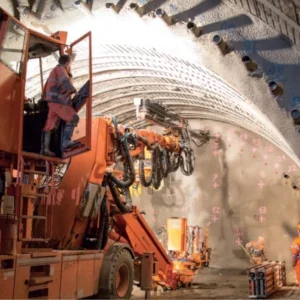A path to achieving a lower carbon footprint in the use of concrete is replacing as much as possible of the CEM I (Portland Cement). One way that several tunnel projects have done this is to use ground granulated blast-furnace slag (GGBS) as a partial replacement for CEM I when producing precast segments for tunnel rings to be installed behind tunnel boring machines (TBMs).
The mix designs for the segments may also have steel fibres reinforcing the concrete (SFRC), which also helps to reduce the carbon footprint compared to the use of bar or mesh steel reinforcement (rebar). UK tunnel projects using SFRC as well as high levels of CEM I replacement with GGBS include the HS2 high-speed rail project on its Chiltern Tunnel currently under construction, and Transport for London’s Silvertown road tunnel where tunnel boring is soon to commence.
Use of CEM I replacement materials, however, is much more challenging for sprayed concrete lining (SCL) performance in tunnels compared to cast concrete. The contemporary liquid accelerators, conventionally used to achieve the required rapid early age strength development, are formulated to work with CEM I and become less effective with increasing proportions of GGBS as partial replacement. For tunnelling, rapid setting and early strength development of SCL are vital performance characteristics, most especially when dealing with fresh excavation faces.
Supported by HS2 Innovation Team funding, ‘proof of concept’ research has been underway since late 2021 to advance the low carbon credentials of SCL while enabling delivery of the required performance characteristics for underground construction applications. Key supporters in the research are also the main works civil contractor (MWCC) joint venture building the London tunnels at the southern end (HS2 contract S1/S2) of the high-speed line – SCS JV– comprising Skanska, Costain and Strabag.
The research has been undertaken by Loughborough University, Peaston Concrete Consultancy, Shotcrete Services, Ecocem and Arup, and was initially supported by a small grant from the Institution of Structural Engineers. The latest research incorporated the findings demonstrated in substantial previous development by Shotcrete Services and Ecocem.
Stage 1 of the research work was recently completed, and the report submitted to the HS2 Innovation Team in June. The findings demonstrate the potential to use calcium aluminate (CA)-based powdered accelerators to successfully facilitate the incorporation of 70% GGBS in sprayed concrete, while achieving tunnelling industry standard performance requirements. Stage 2 of the research is underway.
Key initial points from the research to date have been highlighted in a briefing to the International Tunnelling and Underground Space Association’s (ITA) recently formed Activity Group on Low Carbon Concrete Linings.
CHALLENGE FOR SCL
It is common for sprayed concretes to have cement content of more than 400 kg/m3 which, along with greater admixture usage and dosage rates, leads to higher carbon footprints compared with typical cast-in-situ concretes. The use of supplementary cementitious materials (SCMs), such as GGBS or pulverised fly ash (PFA), with the potential to reduce the carbon impact, has hitherto been limited in sprayed concrete compared with cast or precast applications. This is because they typically react more slowly than CEM I and hence lack the strength development necessary for SCL in tunnels.
There is also the problem of a lack of compatibility of GGBS with aluminium sulfate and sodium aluminate liquid accelerators that are typically employed in sprayed concrete construction. Consequently, the sustainability benefits derived from the use of high-volume CEM I replacement with SCMs, as employed in cast concretes, have not yet been realised in SCL.
The development of calcium aluminate (CA)-based powdered accelerators, however, has the potential to facilitate greater use of replacement SCMs in sprayed concrete. Indeed, GGBS has been sprayed in tunnel applications in Japan. This has been relatively limited, however, due to the increase in the setting time and reduction in the rate of early-age strength development brought about by the addition of GGBS.
In the UK, sprayed concrete subcontractors are typically set up to handle liquid admixtures, and there is relatively limited knowledge on powdered accelerators. This is compounded by industry standard prescriptive specifications for large infrastructure projects in the UK, which typically stipulate liquid alkali-free accelerators, thereby excluding powdered accelerators. This hampers the development and adoption of alternative technologies, such as CA-based powdered accelerators, with the potential to provide equivalent performance.
Relevant cement and concrete Standards, including EN 1971, EN 2062 and BS 85003, permit the use of the replacement SCMs and these are commonly used in cast structural concrete applications. Cement type or combination CIIIB or CEM III/B, for example, can include up to 80% GGBS. Incorporating up to 80% GGBS in the cement has the potential to reduce its embodied carbon by about 70%, from around 860 kgCO2e/tonne (carbon dioxide equivalent mass in kg, per tonne of concrete) to approximately 240 kgCO2e/tonne. The ability to incorporate GGBS at high replacement levels may significantly reduce the carbon footprint of sprayed concrete.
RESEARCH
Between February and August 2021, a consortium of Loughborough University, Peaston Concrete Consultancy, Shotcrete Services, Ecocem and Arup conducted a series of laboratory trials at Loughborough and the University of Leeds. The main aim of the laboratory trials was to complement work previously undertaken by Ecocem and Shotcrete Services in spraying trials on panels to evaluate the impact of high slag content cements with powdered accelerators on the mechanical performance and durability of the resultant sprayed concrete.
Samples from the earlier spraying trials, conducted by Ecocem and Shotcrete Services between 2017 and 2019, showed that the mix had the potential to conform to the specifications for SCL for large UK infrastructure projects, including the HS2 project. The spraying trials used a machine prototype capable of incorporating the CA-based powdered accelerators, with concretes containing up to 70% GGBS. The tests had reference to a specification for the Thames Tideway project.
The results of the spraying trials showed early-age strength development, measured using a needle penetrometer between six and 60 minutes after spraying and nail pull-out tests between six and 24 hours, indicating that at 70% replacement with GGBS, the early-age strength is above the J2 curve from BS EN 144875.
Core compressive strength tested at 28-days along with flexural strength, bond strength and water penetration measurements, performed on samples from trial panels, all met the requirements of the Thames Tideway specification, as did durability testing to establish the resistance to carbonation, chloride ingress, sulfate attack, freeze–thaw and fire damage.
Within the scope of the latest, HS2 Innovation-team-funded ‘proof of concept’ research project, further spraying trials were undertaken in late 2021 and provided a suite of samples for testing by Loughborough and several commercial test houses. Standard notched beam and forthcoming standard notch panel test, requiring both sophisticated test equipment and experienced operatives, were conducted in the laboratory facility of fibre supplier Bekaert. Petrographic and scanning electron microscopy were conducted by Sandberg.
Prior research to the spraying trials at Loughborough involved measuring cement paste setting time using Vicat apparatus to BS EN 196-34, with GGBS replacement from 0 to 80%, liquid accelerators and CA-based powdered accelerators. The work at Leeds involved material characterisation, including X-ray fluorescence (XRF) spectrometry, to determine the chemical composition of the CEM I, GGBS and powdered accelerators. This aided understanding of chemical reactions and microstructural changes that take place during the early stages of hydration when different accelerators are added to the blended cements.
The setting time results indicated that in the CEM I pastes, the conventional liquid alkali-free accelerator based on an aluminium sulfate solution provided much quicker setting times than the CA-based powdered accelerators. As the GGBS content was increased, the setting times in the pastes increased, even with an associated increase in liquid accelerator, indicating a low reactivity with the GGBS.
However, in the cement pastes with the CA-based powdered accelerators, the setting times decreased as the GGBS content increased. At GGBS contents of 70% and 80%, the setting times in the cement pastes with the CA powdered accelerator were comparable with the CEM I pastes with liquid alkali-free accelerator.
As the liquid accelerator used in these laboratory trials is regularly used in sprayed concrete tunnelling applications, this result also indicates that the CA powder accelerators may have the potential to provide the requisite setting times for a sprayed concrete for underground construction at GGBS contents of 80%.
Nonetheless, since the powdered accelerators have a higher pH, this poses an altered health and safety risk profile for operators on-site. This different risk would need managed, with appropriate materials handling procedures adopted, for there to be consideration of use of CA powdered accelerators with appropriate risk mitigation. The procedures would also include ensuring effective mixing at key points such as nozzles, to ensure safety for both immediate needs of operators and long-term performance of linings.
POTENTIAL AHEAD
CA-based powdered accelerators may facilitate the incorporation of 70% GGBS in sprayed concrete, leading toward the use of low carbon sprayed concrete (LCSC) in tunnels. The high proportion of GGBS enables a reduction in the embodied carbon of the cement of potentially more than 60% and has the potential to meet the long-term strength and durability requirements of typical industry standard infrastructure specifications in tunnels.
While the results from the laboratory trials indicate that the CA powdered accelerators may provide the required setting time in SCL containing up to 70% GGBS, further spraying trials are needed to study increasing the GGBS content from 70% to 80% and its impact upon mechanical and durability properties.
Such trials would also investigate the effect on rebound, monitor any dust generated and consider the related effects on productivity, but most critically the short- to medium-term strength gain (one to 28 days), which could become the critical factor for the maximum usable GGBS content.
The Ecocem and Shotcrete trials were conducted using a prototype spraying machine and, consequently, new accelerator dosing and spraying equipment would need to be developed to handle powdered accelerators at a production level.
Materials handling procedures will also need to be developed as part of the next trials to help evaluate appropriate risk mitigation measures to comply with the usual health and safety standards. They would also help toward overcoming concerns such as effectiveness of mixing, points of doing so, and long-term performance of dry powder-based SCL when using the alkaline CA powders.
As briefed in the report to the HS2 Innovation Team and to the ITAtech Activity Group, further research and liaison with industry is needed. This would enable the LCSC innovation to be ‘tunnel ready’, and include not only having the new types of equipment, such as integrated static dosing systems, but also: bulk powder admixture cassette systems to reduce risk in manual handling concerns; refinement of nozzle systems to optimise material performance; blockage clearance systems to reduce or eliminate powder escape in the event of conveyance line blockage; and, automatic failsafe systems to prevent non-compliant materials being placed within the tunnel lining.
The current prototype system is static, although fully mobile spraying systems will enable full application of the findings in the low carbon research for SCL.






